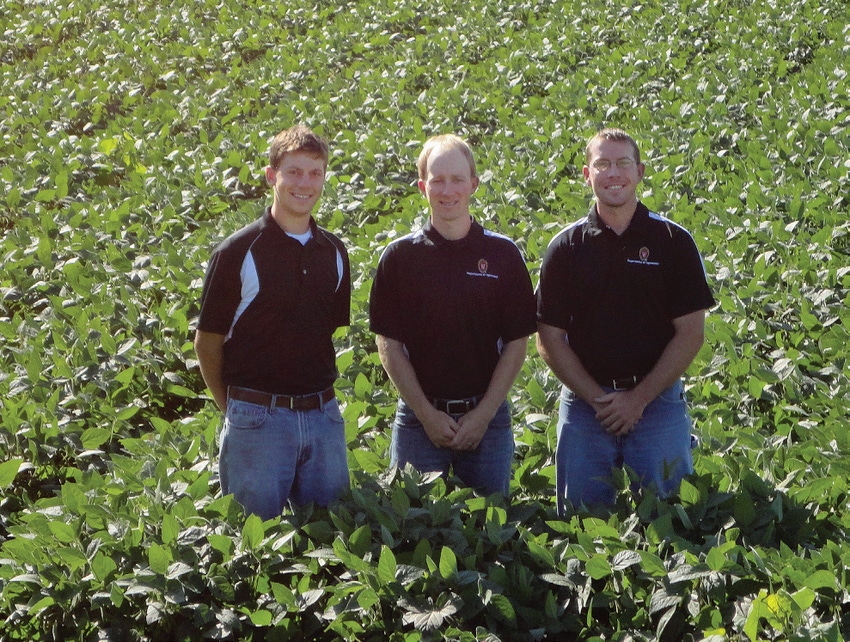
Think DifferentThe University of Wisconsin graduate student Bean Team built upon a comprehensive study of effective soybean agronomic practices (from the United Soybean Board at http://usb-extremebeans.com). This 2012 “Kitchen Sink Project” study spanned 18 sites at six universities over three years.For example, narrow-row soybeans with normal inputs consistently produced the same results as 30-inch rows with the full dose of high-end inputs, it found. Three more years of data from an expanded study involving nine states will be added in 2015.
December 8, 2014

Producing 87-bushel soybeans despite a dry 2013 August comes naturally for three University of Wisconsin-Madison agronomy graduate students. “High yields are our job,” say Adam Gaspar, David Marburger and Ethan Smidt in Arlington, Wis. This year they reached 90 bushels.
They support state Soybean Extension Specialist Shawn Conley, University of Wisconsin-Madison, as graduate research assistants. They apply small-plot research results from different management practices to large field-scale settings. The following, in order of priority, are the basics of their high-yield program:
1) High-yield genetics: Good genetics can add 10-12 bushels per acre, Conley says.
And here’s a twist: They chose a longer-season variety (Group 2.8) than many would have chosen for this area near Madison. “We think a longer maturity group intercepts more light through the growing season to maximize yield,” Gaspar says. Research underway should settle this issue in the next two years, he adds.
They seeded at 170,000 seeds per acre (above economically optimal seeding rates that deliver 100,000 actual plants per acre). “We see slight yield increases past 140,000 seeds per acre but no increase in net profit,” Gaspar adds.
2) Planting early: “Delaying planting past the first week in May here in Madison costs 0.36 bushels per day of delay and 0.5 bushels per day in later May,” Gaspar says.
3) Narrow rows (15 inch): Narrow rows add more soybean yield than did any input because of much earlier canopy closure. Sunlight interception is critical, according to the United Soybean Board “Kitchen Sink Project” (2012) yield study (bit.ly/WpQiGC). It found that narrow-row soybeans with normal inputs consistently produced the same results as 30-in. rows with the full dose of high-end inputs. Sunlight interception is especially vital in mid-season during pod formation, the study found.
“In Madison, we want to close the canopy by R1 (July 1 for this area), and that’s hard in 30-inch rows,” Gaspar says.
“Any row width below 20 inches has about the same yield potential,” Conley says. “If white mold is a concern, growers can drop the population. The penalty for that is minimal compared to row spacing.”
4) Soil fertility: “You can’t approach 100 bushels without at least covering what they remove: 130 pounds of potassium (K) per acre and 85 pounds of phosphorus (P) per acre,” says Gaspar, whose graduate research addresses soybean nutrient needs. “We want to keep high soil-test levels throughout the corn-soybean rotation (P above 25 ppm and K above 140 ppm),” he says.
Micronutrients did not contribute anything to soybean yields, the graduate student team found. “It can be tempting to add things to that post-emerge trip across a field, but they’re only likely to pay on sandier or low-testing soils,” Gaspar says.
Conley adds, “The data on micronutrient benefits for soybean yields is very inconclusive.”
5) Complete seed treatments: Seed treatments should contain both fungicide and insecticide, versus fungicide-only seed treatments, for more consistent yield increases, Gaspar says. His team’s seed treatment had two modes of action to target fungi, plus an insecticide.
Adding an insecticide showed more than a 2-bushel yield increase in Wisconsin-only trials. Yield increases were smaller and less frequent when a fungicide-only seed treatment was used, Gaspar says.
6) Pre-emerge herbicides: “Start with clean fields. Limit early season grass and broadleaf weed competition, and limit the size and number of weeds exposed to post-emerge applications,” Gaspar says.
The team’s soybean herbicide program had five modes of action costing about $35 per acre. They don’t have resistance problems.
Post-emerge herbicides offer limited modes of action between glyphosate, Liberty Link, PPOs and ALS herbicides. “The future is bright with a lot more options,” Gaspar says. “Dicamba, 2,4-D and HPPDs for beans are in the pipeline for post-emergent weed control.”
7) SCN management: Know your field disease pressure, pest pressure, and soybean cyst nematode (SCN) levels; use resistant varieties; and rotate your genetic resistance along with crop rotation. According to some data, if these measures are not taken, there can be up to 50% yield hits with 10,000 SCN eggs per 100 cc of soil (the standard sample lab size), Gaspar says. SCN is the No. 1 yield-robbing pathogen.
8) Scouting and knowing your field history: There’s no replacement for boots on the ground to detect Pythium, Rhizoctonia, Phytophthora, aphids or white mold that unfold quickly. The grad students scout for white mold at the R1 stage and use an aphid threshold of 250 per plant. “We used a non-pyrethroid insecticide in 2012 on spider mites once we found them,” Gaspar says. “We use an integrated pest management approach for foliar insecticide and fungicide applications.”
At this Madison location, late-season fungicide applications pay off in response to actual disease pressure rather than prophylactically, says Conley, the Wisconsin soybean specialist.
9) Other details: The soybean team rotates its beans with corn, so it doesn’t use inoculants. They chisel-plow in the fall and cultivate in the spring. “Data shows little difference between no-till and conventional tillage in corn-soybean rotation,” Gaspar adds. “We no-till on hillier ground.”
Despite all these measures, the grad student team still trailed Monroe, Wis., DeVoe Farms’ soybean yield by 5 bushels.
About the Author(s)
You May Also Like



